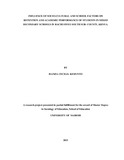| dc.description.abstract | Retention of students and academic performance is a crucial process in many of the
learning institutions today. This study investigated the influence of socio-economic and
school factors on retention and academic performance of students in mixed secondary
school in Rachuonyo South Sub-County-Kenya. In particular the study sought to
determine the influence of family factors and peer pressure on retention and academic
performance of students in Rachuonyo South sub-county; the influence of school related
factors on retention of students in mixed secondary schools in Rachuonyo South SubCounty;
the influence of socio-cultural factors on retention and academic performance of
students in public mixed secondary schools in Rachuonyo South Sub-County. The
researcher used questionnaires and interview schedule, as research tools. Analysis of
primary data was done qualitatively and quantitatively. Both qualitative and quantitative
data were collected and analyzed. Qualitative data was analyzed in narration form while
quantitative data was analyzed by use of percentages, means and frequencies. Tables
were used to present data for easy interpretation. The findings from this study are
expected to assist practitioners’ gain better understanding on the key determinants on
retention and academic performance of students.
The findings of the first objective indicated that majority of the parents 72.6% preferred
to educate boys to girls. It was also found that in large families parents preferred to
educate boys to girls. Both boys and girls were equally influenced to drop out of school
by their peers by 50%.
The findings of the study showed that 86.3% of the girls dropped out of school due to
pregnancy and 84.3% were married early. More girls 95% dropped out of school for
wage labour as compared to boys at 83.8%. More male students 89.3% were influenced
by their peers while 88.3% learnt to take drugs from their family members. The female
students were less 15% influenced by peers while 80% learnt to smoke from family
members.
The findings of the study indicated that majority 56.9% of the schools lacked adequate
physical facilities such as laboratories, libraries, furniture, classrooms and sanitary
facilities for both girls and boys. 98% of the respondents noted that school dropout rates
was occasioned by school levies on lunch 95%, remedial studies 90%, uniform and
95%development funds. Therefore, school levies contributed significantly to the
dropping out of students.
The researcher recommends that a study be conducted on the strategies being employed
by school administrators to cope with challenges of retention and academic performance
of girls in mixed secondary schools.
A study be conducted under influence of socio-cultural and school related factors on
retention and academic performance in same sex schools in Rachuonyo south sub-county
and the rest of the country. | en_US |

